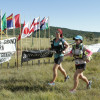I need to sort out thoughts about the coming year and beyond, and that’s another reason I’m looking forward to this 24-hour hamster-wheel ultra on new year’s eve—it’ll be a retreat of sorts.

 The Runner's Trip: Run Long, Travel Far, Discover More
trail running and travel blog by Sarah Lavender Smith
The Runner's Trip: Run Long, Travel Far, Discover More
trail running and travel blog by Sarah Lavender Smith

I need to sort out thoughts about the coming year and beyond, and that’s another reason I’m looking forward to this 24-hour hamster-wheel ultra on new year’s eve—it’ll be a retreat of sorts.

I spent ten months coaching two clients for the Grand to Grand Ultra and the Atacama Crossing. Here’s the outline of their training plans, and their stories of what the events were like, to show how to meet the myriad challenges of an ultra-long stage race—and, perhaps, to inspire your new year’s goals.

I can’t recall how or why we started the new year with the “see ya Tuesday at 9 at the lake”—two ultra-distance trail runners meeting midweek for a paved, flat, easy loop. I needed a friend, a counselor, a reminder of the best, most humorous and resilient sides of the human spirit. Each Tuesday, we […]

Having spent the past two weeks developing several long-range training plans for clients, which span 16 to 24 weeks in preparation for a top-goal ultra, I thought I’d share the process and use my own training horizon for the Mauna to Mauna Ultra as an example.

Some of you may have expected a UROY post in which I geek out about my Ultrarunner of the Year ballot picks like many esteemed blogging peers. I decided to write a middle-aged-mom diary entry instead with some real-life, empirically untested self-help tips.

My intention is not to advocate any strict nutritional plan, but rather, to share the process that worked for me, because I gave myself a nutritional tuneup and am happy to report it worked (for the most part … )

So much of my stress is tied to perfectionism, to wanting to get it just right or not do it at all. I overthink and underproduce.

During 2015, I often felt worn out, moody, heavy or bloated, and alternately frazzled and unproductive. Here are three ways I’m trying to fix that.

The story of my client Jami Sutter shows how careful, steady training and mental determination can lead to a highly respectable mid-pack finish in a grueling stage race. Jami answers questions about the highs, the lows and the lessons learned.

After a hiatus from running and blogging, I’m coming back slowly and carefully. Here are 12 pieces of advice for anyone recovering from a running injury or trying to prevent one.